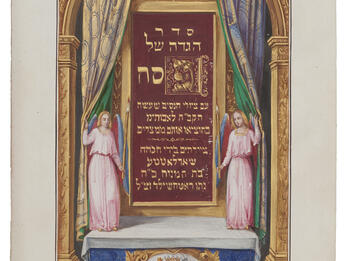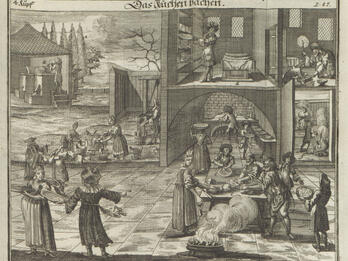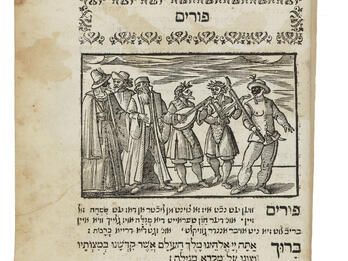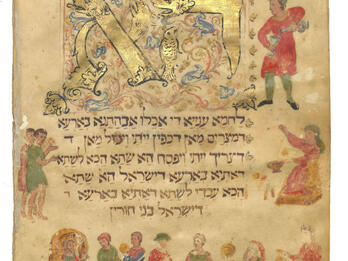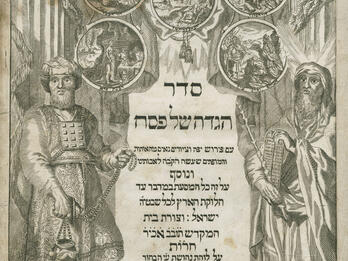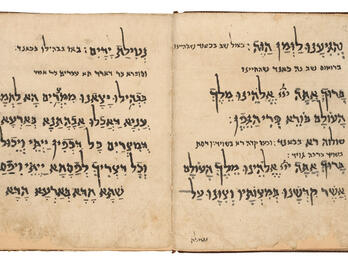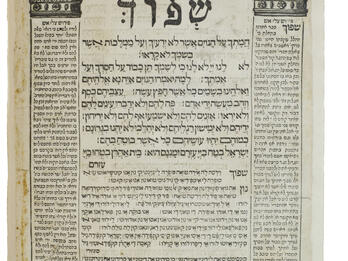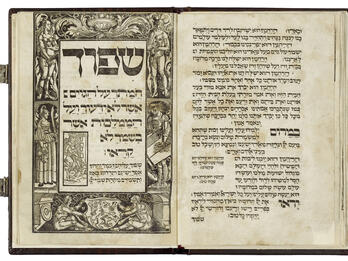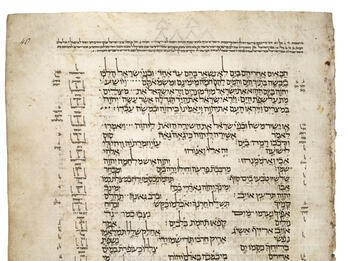Showing Results 11 - 20 of 28
Public Access
Image
One of Charlotte von Rothschild’s most outstanding works is the only known nineteenth-century Hebrew manuscript to have been illuminated by a woman.
Contributor:
Charlotte von Rothschild
Places:
Frankfurt am Main, German Confederation (Frankfurt am Main, Germany)
Date:
1842
Subjects:
Categories:
Public Access
Image
This illustration depicting Jews baking matzah and cleaning the house for Passover appeared in the book Jüdisches Ceremoniel (Jewish Ceremonial Customs), by Paul Christian Kirchner, a Jewish convert…
Contributor:
Paul Christian Kirchner, Johann Georg Puschner, Sebastian Jugendres
Places:
Nuremberg, Holy Roman Empire (Nuremberg, Germany)
Date:
1724
Subjects:
Categories:
Restricted
Image
These woodcuts appeared in Sefer minhagim (Book of Customs), a very popular Yiddish book published by Giovanni di Gara, the leading publisher of Jewish books in Venice from 1564 to 1609. It was the…
Contributor:
Artist Unknown
Places:
Venice, Venice (Venice, Italy)
Date:
1600/1
Subjects:
Public Access
Image
Between 1723 and 1737, illustrator Bernard Picart partnered with the Dutch bookseller, editor, and publisher Jean-Frédéric Bernard on Cérémonies et coutumes religieuses de tous les peuples du monde (R…
Contributor:
Bernard Picart
Places:
Amsterdam, Dutch Republic (Amsterdam, Netherlands)
Date:
1725
Subjects:
Restricted
Image
In 1583, Mattetiah ben David Spagnolo completed this illuminated Haggadah for Leon ben Judah Bili. Greek (Romaniote/Byzantine) Jews had lived on the island of Crete since the Second Temple period…
Contributor:
Mattetiah Spagnolo
Places:
Candia, Venice (Heraklion, Greece)
Date:
1583
Subjects:
Categories:
Public Access
Image
This Haggadah from Amsterdam was printed by Joseph ben Abraham Athias and is adorned with elaborate copper etchings by artist Abraham Bar Jacob. It was the first Haggadah to include these sorts of…
Contributor:
Joseph ben Abraham Athias, Abraham Bar Jacob
Places:
Amsterdam, Dutch Republic (Amsterdam, Netherlands)
Date:
1695
Subjects:
Restricted
Image
. . . and caused us to reach this appointed time.On the first night, one should recite the blessing “who has kept us alive . . .” But on the second night, one should not read it.Blessed are…
Contributor:
Unknown
Places:
Kaifeng, Qing Dynasty (Kaifeng, China)
Date:
17th Century
Categories:
Restricted
Image
This Haggadah from Venice was commissioned by Moses ben Gerson Parenzo, the last of the Parenzo Hebrew printers, and issued at the Caleoni press on behalf of the Bragadini family. This page shows the…
Contributor:
Moses ben Gershon Parenzo
Places:
Venice, Venice (Venice, Italy)
Date:
1629
Restricted
Image
This Haggadah from Prague, printed by Gershom and Grunim Katz with illustrations that are thought to be by Ḥayyim ben David Shaḥor, is one of the earliest Haggadahs ever printed. It was the first…
Contributor:
Gershom Katz, Ḥayyim Schwarz
Places:
Prague, Holy Roman Empire (Prague, Czech Republic)
Date:
1526
Subjects:
Restricted
Image
Song at the Sea (Exodus 15), Leningrad Codex, 1009 CE. The photo shows the first fourteen verses of the poem (Exodus 15:1–14) and a few prose verses from the end of the preceding chapter. The text of…
Places:
Cairo, Egypt
Date:
1009


